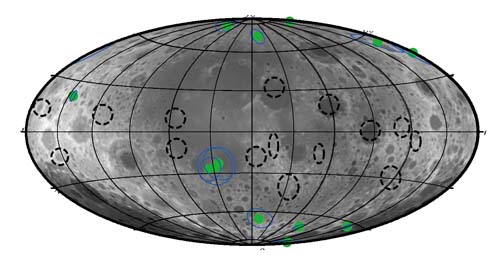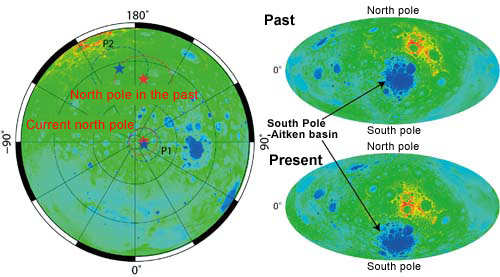TOP > Report & Column > The Forefront of Space Science > 2014 > Lunar Dynamo Found Through Magnetic Fields and Traces of Polar Wander
![]()

Figure 2 shows loci of the lunar magnetic poles (positive pole) determined reliably from the analysis of magnetic anomalies. The magnetic poles tend to be distributed in high latitude regions and the low-to-mid latitude regions in both the northern and southern hemispheres. The fact that the positive poles are distributed in both the northern and southern hemispheres suggests that possibly the lunar dynamo had experienced a phenomenon called "reversal". Reversal has been well confirmed in the geomagnetic field, which is a phenomenon that the orientation of the bar magnet reverses its polarity. We take the negative poles for all the magnetic poles in the southern hemisphere so that all of the magnetic poles are plotted in the northern hemisphere. As a result, the unity of the magnetic poles improves fairly well, and we find that the magnetic poles are concentrated at two places: one is around 30-45 degrees in the latitude and the other near the rotation axis of the moon (Figure 3 left). Since similar results are also obtained by analyzing the data from the Lunar Prospector spacecraft by USA, the results are reliable. 

What does it mean when the magnet poles concentrate at 2 different places? Take the earth as an example. Taking the average for a long time, the position of the mean geomagnetic pole coincides with the rotation pole. This is an important property of the large-scale magnetic field created by dynamo in the core. Based on the property, we have 3 important inferences summarized in the following:
The Meanings of the Polar Wander The 3 discoveries mentioned above are all important for understanding the origin and evolution of the moon. Here we take an example to show the meanings of the polar wander. There is the largest impact basin on the moon called the South Pole-Aitken basin located at the mid-to-high latitudes in the farside of the moon (Figure 3 lower right). To form such a large impact basin, there should be a collision with a deep inclination from the south side of the moon, which is theoretically a strict condition. On the other hand, if the polar wander had occurred, the South Pole-Aitken basin might be located at the place which was close to the paleo-equator of the moon (Figure 3 upper right). Then without considering any special conditions, the basin formation can be explained by a giant impact towards the vicinity of the paleo-equator. When we take the polar wonder into consideration, the formation model of the largest impact basin on the moon may be quite different. It is expected that in the future, a new evolution model of the moon can be made based on the presence of the polar wander. Although 適aguya・finished its role and came back to the moon in June 2009, we still have a large amount of data obtained by 適aguya・ which should be investigated to understand the moon. Let us look forward to the research results of 適aguya・and LMAG in the future. (Futoshi Takahashi)
|
||||||||||




